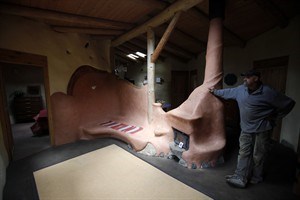
Cob workshop instructor Patrick Hennebery stands inside the healing centre at O.U.R. EcoVillage in Shawnigan Lake Thursday June 13, 2013.THE CANADIAN PRESS/Chad Hipolito
June 13, 2013 - 8:30 AM
VICTORIA - Living in a cob house isn't something homeowners do to blend with the neighbourhood and Patrick Hennebery knows this firsthand.
He lived in a cob house on Mayne Island, one of the Gulf Islands north of Victoria, for 10 years.
Hennebery is the owner of Cobworks and routinely teaches workshops and internships, including a four-month course he's currently conducting at Shawnigan Lake's Our Ecovillage on Vancouver Island.
"This house we're building at the Ecovillage is, I think, my 24th home," said Hennebery. "I've also built various small buildings, fireplaces, ovens, garden walls and benches."
Cob is an ancient building material that has been used in some of the oldest man-made structures.
Using clay, sand, straw and water, Hennebery builds eco-friendly homes featuring other recycled and found materials, which helps keep the overall cost of construction down.
"On a conventional framed house the labour is about half the cost and the materials are half," he said. "With a cob house the materials are way less, but the labour is still there.
"Unlike a conventional house where you need a carpenter, with a cob house a lot of the labour can be learned by the owner in a workshop. We encourage people to bring as much to the project as they can."
Cob construction has recently increased in popularity on the West Coast, and one reason people are choosing cob is the way the walls retain heat, helping to keep heating and insulation costs down.
But elsewhere in Canada, Hennebery said those interested in building with cob would have to include natural building materials like straw bales to help with insulation.
"I'm working on designing some small houses that would be good anywhere in Canada," he said.
"You get the straw bales, which are good insulation, and cob, which has thermal mass. I want to design some houses where you have straw bale with a foot (30 centimetres) of cob inside. That way, no matter where, you can include the heating properties of both construction materials."
Even though Hennebery suggests cob construction is best suited to the West Coast's climate, Gena Arthur, owner of Halifax's Eco-Developments, is working on building her first cob house.
Arthur founded Eco-Developments in 2009 after travelling to Vancouver Island to learn about building with cob.
"I started off very small building cob ovens," said Arthur. "I went on to build the first community oven in Nova Scotia, which is the Park Avenue Community Oven which is built on the Dartmouth Commons."
But building with cob on Canada's East Coast is different than on the West Coast, and one considerable difference is in the foundation.
The seismic activity in and around British Columbia means there are specifications around the foundation that aren't present in the building standards in Nova Scotia.
"I was able to obtain a permit to do a dry stacked stone foundation because we don't have any seismic activity here," said Arthur. "That was pretty major because we did the very first permitted foundation."
The thickness of the cob walls is also much different in Nova Scotia. According to Arthur, the walls for her home will be nearly a metre thick, unlike the 46-centimetre-thick walls Hennebery builds.
Arthur will be putting the walls and roof on her home in the next three weeks with the help of an apprentice from Providence, R.I., and nearly 60 interested volunteers.
"The interest from the public has been phenomenal," she said. "We have hundreds of people that are waiting to come and see our project, and we've just been holding off because it isn't much right now."
———
Online:
www.cobworks.com
http://ourecovillage.org/
http://eco-developments.ca/
News from © The Canadian Press, 2013